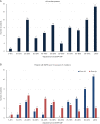EGFR variant allele frequency predicts EGFR-TKI efficacy in lung adenocarcinoma: a multicenter study
- PMID: 33718012
- PMCID: PMC7947383
- DOI: 10.21037/tlcr-20-814
EGFR variant allele frequency predicts EGFR-TKI efficacy in lung adenocarcinoma: a multicenter study
Abstract
Background: Although lung adenocarcinoma (LADC) with sensitizing mutations of the epidermal growth factor receptor (EGFR) is highly sensitive to EGFR tyrosine kinase inhibitors (EGFR-TKIs), in most cases disease progression inevitably occurs. Our aim was to investigate the predictive and prognostic significance of adjusted tumoral EGFR variant allele frequency (EGFR-aVAF) in the above setting.
Methods: Eighty-nine Caucasian advanced-stage LADC patients with known exon-specific EGFR mutations undergoing EGFR-TKI treatment were included. The correlations of EGFR-aVAF with clinicopathological variables including progression-free and overall survival (PFS and OS, respectively) were retrospectively analyzed.
Results: Of 89 EGFR-mutant LADC patients, 46 (51.7%) had exon 19 deletion, while 41 (46.1%) and 2 (2.2%) patients had exon 21- and exon 18-point mutations, respectively. Tumoral EGFR-aVAF was significantly higher in patients harboring EGFR exon 19 mutations than in those with exon 21-mutant tumors (P<0.001). Notably, patients with EGFR exon 19 mutant tumors demonstrated significantly improved PFS (P=0.003) and OS (P=0.02) compared to patients with exon 21 mutations. Irrespective of specific exon mutations, a statistically significant positive linear correlation was found between EGFR-aVAF of tumoral tissue and PFS (r=0.319; P=0.002). High (≥70%) EGFR-aVAF was an independent predictor of longer PFS [vs. low (<70%) EGFR-aVAF; median PFSs were 52 vs. 26 weeks, respectively; P<0.001]. Additionally, patients with high EGFR-aVAF also had significantly improved OS than those with low EGFR-aVAF (P=0.011).
Conclusions: Our study suggests that high (≥70%) EGFR-aVAF of tumoral tissue predicts benefit from EGFR-TKI treatment in advanced LADC and, moreover, that exon 19 EGFR mutation is associated with high EGFR-aVAF and improved survival outcomes.
Keywords: Epidermal growth factor receptor mutation (EGFR mutation); lung adenocarcinoma (LADC); variant allele frequency (VAF).
2021 Translational Lung Cancer Research. All rights reserved.
Conflict of interest statement
Conflicts of Interest: All authors have completed the ICMJE uniform disclosure form (available at http://dx.doi.org/10.21037/tlcr-20-814). The authors have no conflicts of interest to declare.
Figures



Similar articles
-
Clinical outcomes of EGFR-TKI treatment and genetic heterogeneity in lung adenocarcinoma patients with EGFR mutations on exons 19 and 21.Chin J Cancer. 2016 Mar 21;35:30. doi: 10.1186/s40880-016-0086-2. Chin J Cancer. 2016. PMID: 27001083 Free PMC article.
-
Picoliter-Droplet Digital Polymerase Chain Reaction-Based Analysis of Cell-Free Plasma DNA to Assess EGFR Mutations in Lung Adenocarcinoma That Confer Resistance to Tyrosine-Kinase Inhibitors.Oncologist. 2016 Feb;21(2):156-64. doi: 10.1634/theoncologist.2015-0288. Epub 2016 Jan 14. Oncologist. 2016. PMID: 26768482 Free PMC article.
-
KRAS Mutations Predict Response and Outcome in Advanced Lung Adenocarcinoma Patients Receiving First-Line Bevacizumab and Platinum-Based Chemotherapy.Cancers (Basel). 2019 Oct 9;11(10):1514. doi: 10.3390/cancers11101514. Cancers (Basel). 2019. PMID: 31600989 Free PMC article.
-
Uncommon mutation types of epidermal growth factor receptor and response to EGFR tyrosine kinase inhibitors in Chinese non-small cell lung cancer patients.Cancer Chemother Pharmacol. 2017 Dec;80(6):1179-1187. doi: 10.1007/s00280-017-3464-9. Epub 2017 Oct 24. Cancer Chemother Pharmacol. 2017. PMID: 29063948
-
Overall Treatment Strategy for Patients With Metastatic NSCLC With Activating EGFR Mutations.Clin Lung Cancer. 2022 Jan;23(1):e69-e82. doi: 10.1016/j.cllc.2021.10.009. Epub 2021 Oct 25. Clin Lung Cancer. 2022. PMID: 34865963 Review.
Cited by
-
The Advantage of Targeted Next-Generation Sequencing over qPCR in Testing for Druggable EGFR Variants in Non-Small-Cell Lung Cancer.Int J Mol Sci. 2024 Jul 19;25(14):7908. doi: 10.3390/ijms25147908. Int J Mol Sci. 2024. PMID: 39063150 Free PMC article.
-
[Correlation between Immune Microenvironment Features and EGFR Mutation Status in Lung Adenocarcinoma].Zhongguo Fei Ai Za Zhi. 2023 Mar 20;26(3):204-216. doi: 10.3779/j.issn.1009-3419.2023.101.07. Zhongguo Fei Ai Za Zhi. 2023. PMID: 37035883 Free PMC article. Chinese.
-
Novel MRPS9-ALK Fusion Mutation in a Lung Adenocarcinoma Patient: A Case Report.Front Oncol. 2021 Jun 8;11:670907. doi: 10.3389/fonc.2021.670907. eCollection 2021. Front Oncol. 2021. PMID: 34168990 Free PMC article.
-
Anaplastic lymphoma kinase inhibitors-a review of anticancer properties, clinical efficacy, and resistance mechanisms.Front Pharmacol. 2023 Oct 25;14:1285374. doi: 10.3389/fphar.2023.1285374. eCollection 2023. Front Pharmacol. 2023. PMID: 37954850 Free PMC article. Review.
-
Novel RICTOR amplification harbouring entities: FISH validation of RICTOR amplification in tumour tissue after next-generation sequencing.Sci Rep. 2023 Nov 10;13(1):19610. doi: 10.1038/s41598-023-46927-x. Sci Rep. 2023. PMID: 37949943 Free PMC article.
References
LinkOut - more resources
Full Text Sources
Other Literature Sources
Research Materials
Miscellaneous
